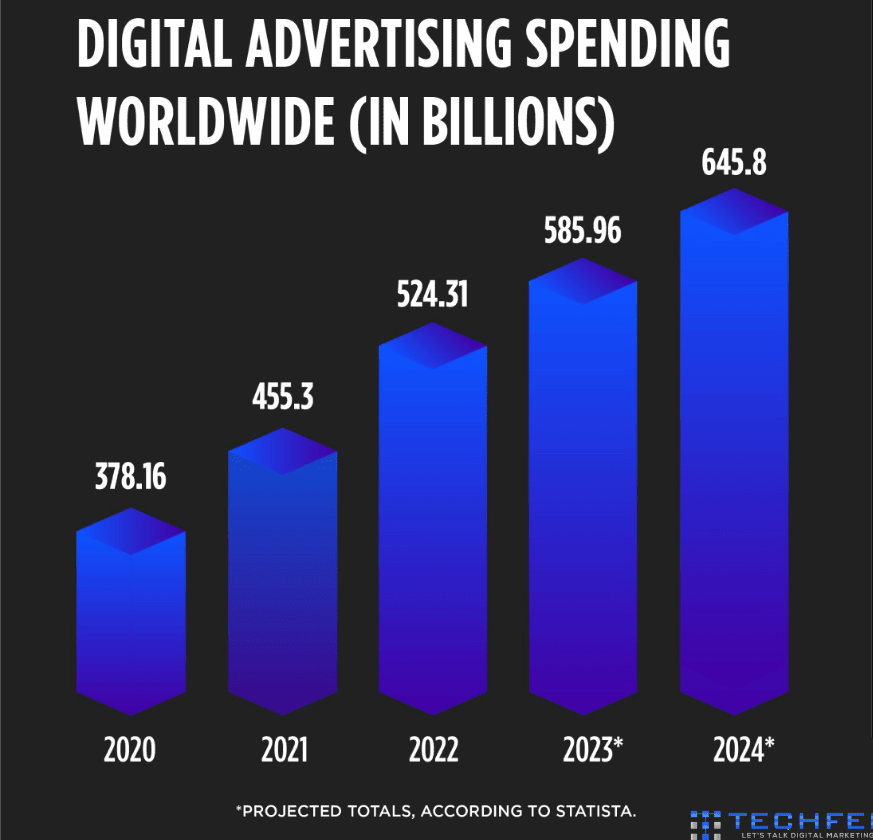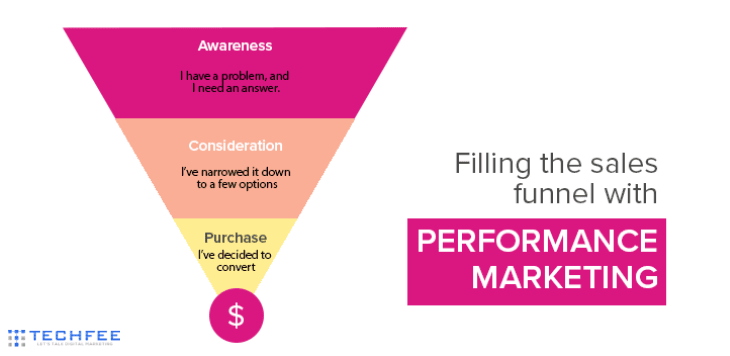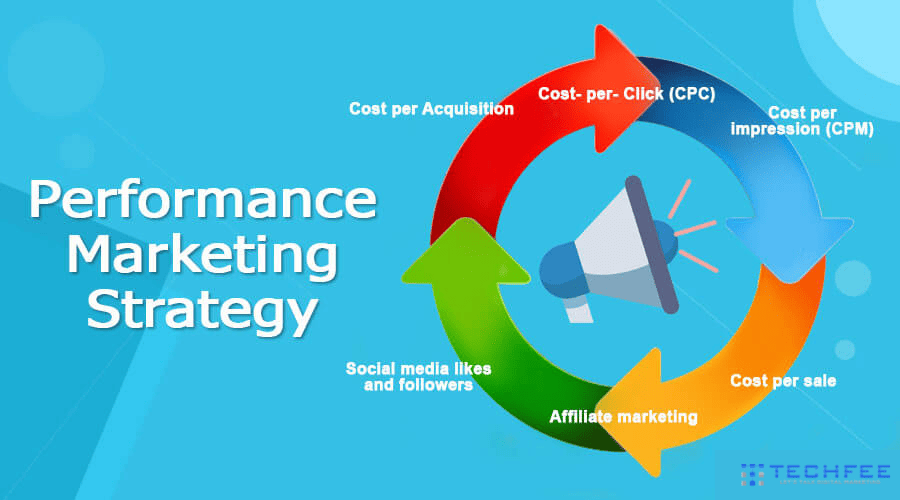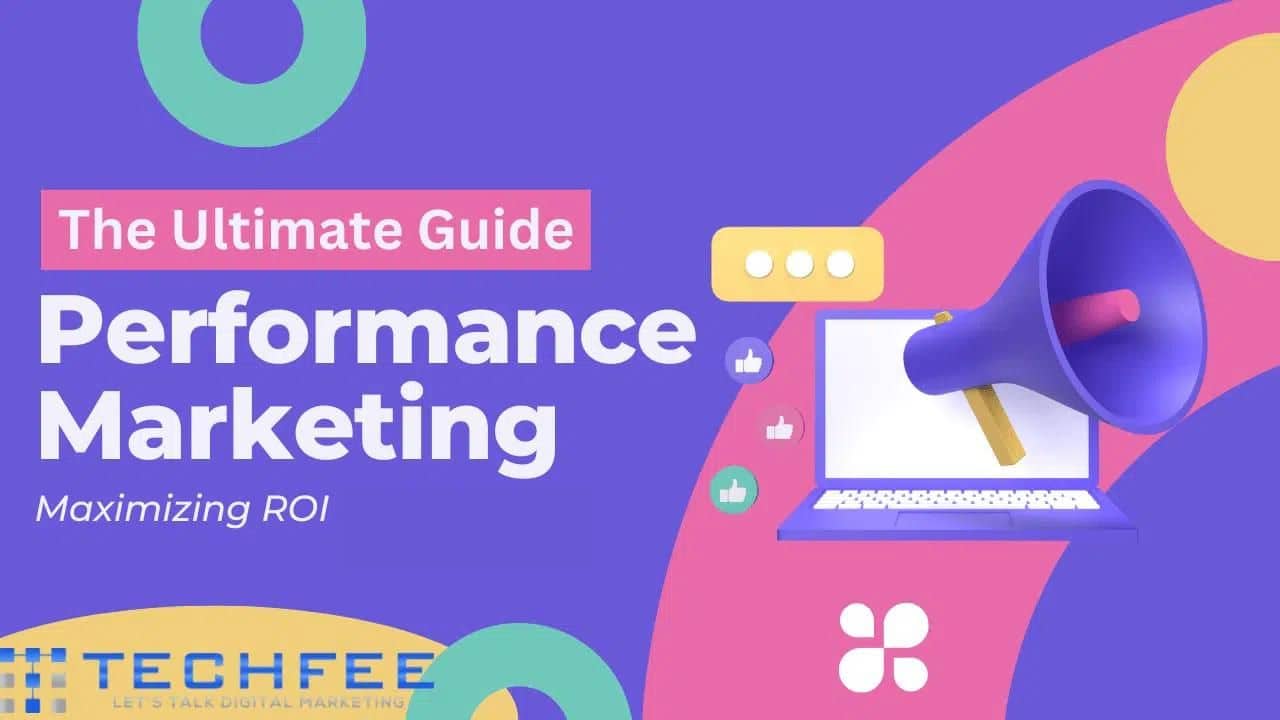As we move into 2024 and beyond, businesses must look ahead at the latest trends in performance marketing. What worked well in 2023 may be less effective in the new year, so staying ahead of the curve is critical.
Whether you’re a digital marketer, blogger, online marketer, freelancer, a seasoned pro, or just starting, this guide will give you the insights you need to dominate your field in the coming year.
We’ll explore the top 20 performance marketing trends for 2024 and beyond. We’ll cover everything from attribution models to omnichannel marketing, so you can ensure your campaigns are optimized for maximum ROI. So let’s get started!
Table of Contents
ToggleWhat is Performance Marketing?
Performance marketing is an advertising model that focuses on actual return on investment. Unlike traditional media, such as TV and radio ads, performance marketing works by delivering quantifiable results like leads or sales.
What’s nice about this kind of advertising is that it’s measurable, allowing you to track how well campaigns are working while being agile enough to make changes quickly if need be accurate. It also gives you the power to take control of budgets and proactively adjust campaigns to maximize success.
Performance marketing leverages data insights and targeted consumer segments for maximum impact with minimal effort – all without sacrificing creative flair. This approach helps businesses maximize revenue opportunities and eliminate unprofitable sectors from their campaigns.
Performance Marketing Types
Performance marketing is an incredibly effective strategy for businesses and marketers alike – it focuses on tangible (and measurable!) results. Performance marketing has several types, so let’s dive into what they are.
Performance marketing types include paid search, affiliate marketing, email campaigns, display advertising, and cost-per-action campaigns. Each type allows businesses to track metrics such as leads generated, customer acquisition costs, and ROI.
The most common type of performance marketing is pay-per-click (PPC), where advertisers pay a fee each time their ad is clicked. Cost per acquisition marketing (CPA) is similar to PPC, but instead, you pay based on when customers take action, like making a purchase or signing up for a service.
And finally, cost per lead (CPL) is where marketers pay for each qualified lead they generate. Performance marketing gives businesses flexibility and control of their budget, allowing them to reap the rewards of achieving their goals.

How Does Performance Marketing Work?
Performance marketing is a powerful way for businesses to get their product to the right target audience. It is a form of online advertising where companies pay for measurable outcomes — for example, clicks or conversions — rather than impressions.
Marketers use techniques and tactics like SEO, paid search, affiliate marketing, email campaigns, and social media management to achieve those outcomes. The data collected from these strategies help marketers decide which channels are most effective in reaching their desired goals.
Driven by data and analytics, organizations can strategically track their success rate regarding clicks, engagements, sales, and more to inform their future tactics. Strategies like these will help organizations understand how they’re progressing toward their goals so they can determine what’s working without wasting time or resources.
Overall, performance marketing is a great way to optimize your business’s efforts and ensure you’re targeting your potential customers with the right message at the right time.
Advertisers can carefully choose their desired platform for ad placement, with every performance affecting the price. With these several payment options available in performance marketing, advertisers can find one that best suits their campaign needs:
- Cost Per Click (CPC)
Advertisers reward the sites that attract visitors by paying for every click of their ads. This valuable form of customer engagement can easily direct high-traffic volumes to your site with each ad clicked!
- Cost Per Impression (CPM)
Maximize the impact of your ad by understanding impressions. With CPM, you pay for every thousand views; leverage this pricing model to get more bang for your buck!
- Cost Per Sale (CPS)
CPS is a flexible and efficient payment system in which profits are only generated when an advertisement leads to a sale. This approach also has proven successful for many affiliate marketers worldwide.
- Cost Per Lead (CPL)
CPL offers a great way to generate leads and drive sales. By paying when someone signs up for something like an email newsletter or webinar, you can create opportunities to follow up with customers directly and maximize your return on investment.
- Cost Per Acquisition (CPA)
Cost per acquisition offers an all-encompassing approach to advertising, in which advertisers are only required to pay once a desired action has been fulfilled. This could range from making a sale or signing up for newsletters and updates – the possibilities are limitless!
What Makes Performance Marketing Unique?
What makes performance marketing unique is its ability to focus on measurable results and a quick return on investment. With performance marketing, as opposed to other types of marketing, advertisers know exactly how much each sale or lead costs because it’s trackable and transparent.
This also means tremendous potential for scaling if the campaign itself proves successful; if it proves unsuccessful, the advertiser can quickly test out different strategies without significant losses.
Furthermore, performance advertising allows companies to target specific audiences with website retargeting and pinpoint accurate budgeting through cost per acquisition mechanism.
Ultimately, performance marketing offers flexibility, scalability, and precision to maximize return on investment, all while generating quality leads or sales.
Performance Marketing vs. Digital Marketing
Performance marketing and digital marketing are two different types of marketing that share similarities but also have distinct differences. Performance marketing focuses on specific results — usually either sales performance or direct lead generation — and measures performance against a predetermined KPI.
Digital marketing, on the other hand, is more broadly focused on creating brand awareness across multiple online channels such as social media, search engine marketing (SEM), and email remarketing.
Performance marketing is mainly organized using an affiliate network, while digital marketing does not need an affiliate network but concentrates on tactics like A/B testing or developing engaging content. Each type of approach has advantages to consider when trying to arrive at the optimal mix of performance vs. digital for your company goals.
Performance Marketing vs. Brand Marketing
Performance and brand marketing are two distinct fields in advertising, though there is plenty of overlap between them. Performance marketing focuses on concrete goals, such as achieving clicks or potential customer conversations through campaigns heavily focused on data-driven decisions.
On the other hand, brand marketing focuses on creating a compelling long-term image for a business that is usually related to softer qualities like emotion and authenticity. Performance marketing typically involves a “test and learn” approach, while brand marketing requires balancing awareness with relevance.
Performance and brand marketing are essential for successful businesses, but depending on which goal you’re trying to achieve, one may be more suitable.

Benefits of Performance Marketing
Performance marketing offers an efficient, cost-effective way to bring customers to your business. Benefits can include lower advertising costs by only paying for results rather than impressions or page views, greater reach through targeting specific customer segments, and higher conversion rates due to increased engagement.
The Benefits of Performance Marketing are often overlooked by those unfamiliar with the concept. However, it can deliver significant short-term and long-term advantages of helping you drive more sales and increase customer loyalty. Benefits include improved relevance and targeting; with performance marketing, you can focus on reaching a specific audience who might be more likely to convert into customers or consider your products/services.
This means that instead of just hoping that people find your message amongst the hundreds of other messages in their inbox, you can reach an audience you can genuinely engage with. Performance marketing also helps improve return on investment (ROI) since campaigns can be specifically tailored to maximize feedback from a potential customer base.
Furthermore, it lets you track existing campaigns’ performance over time to ensure they deliver the highest return on investment. Overall, performance marketing is an excellent way to draw more customers toward your business and ensure that each ad dollar is maximized for maximum effectiveness.
Top Performance Marketing Channels
Top performance marketing channels include search engine optimization (SEO), social media, Banners (Display Ads), Native Advertising, Content Marketing, email campaigns, influencer partnerships, direct mail campaigns, and traditional options are trade shows, print ads, and more.
SEO is the practice of optimizing a website to be found by users searching relevant topics online. Social media and email campaigns are great for promoting content and engaging with users in two-way communication.
Additionally, you can use digital advertising to reach potential customers on other websites through display ads. All these strategies together make up top-performance marketing channels that focus on providing an adequate return on investment for your business goals and objectives.
By assessing each channel’s cost efficiency and effectiveness for your particular goal or product area, you can build a well-rounded portfolio of performance marketing strategies to provide your company with the maximum reach at the lowest possible cost.
How to Build a Performance Marketing Strategy

Performance marketing is a complex practice – essential for building engagement with the right audiences. With our step-by-step guide, we can start crafting success stories through many available channels and campaigns. Leverage these key steps to create an effective strategy to get our performance campaign up and running toward peak success!
Step 1: Establish Your Campaign Goal
To ensure the success of any campaign, establishing clear objectives prior to launch is fundamental. From generating brand exposure and website traffic, all the way through lead generation and sales – defining your goals will direct inclusion criteria for areas such as where ads are displayed or which audiences they should target.
The most widely employed digital marketing aspirations include: brand awareness; remarketing/retargeting activities; engagement-building initiatives; leads via promotions & offers alike, plus making actual product purchases too! With these ambitions defined before commencing campaigns on ad platforms over numerous channels, you can create a focussed approach with an increased probability of reaching desired outcomes at actual ROI rates.
Step 2: Choose Your Digital Channel(s)
For performance marketing success, it pays to diversify. Spreading exposure across different channels helps broaden conversions and target goals. Consider specialized platforms for your conversion types, like affiliate advertising or social media networks – doing so can significantly boost reach potential.
Native ads are a great way to capitalize on enhanced visibility over traditional display campaigns, too – increasing the likelihood of successful outcomes in today’s competitive marketplace environment.
Step 3: Create And Launch The Campaign
Crafting an effective performance marketing campaign requires a nuanced understanding of the target audience – their pains, desires, and what appeals to them. The better you comprehend these facets, the more successful your ad design and messaging will be when it comes time for creation – from visuals down to technical details like character limits across each platform or channel.
Step 4: Measure And Optimize Your Campaign
Once a performance campaign is live, the real challenge for marketers begins. Analyzing data and surpassing ROI goals starts with precise analytics and tracking metrics– which are essential to determining successful traffic sources.
Then devote ad investment according to what works best, allowing you to grow sales while honing in on optimal channels, targeted audiences, and objectives that will increase returns!
Step 5: Handle Potential Pitfalls
Performance marketing can bring tremendous benefits, but it also has challenges that must be considered. For example, properly mitigating potential issues like brand safety violations and publisher fraud are best done by focusing resources on high-quality advertising networks where these items are handled reliably and professionally.
Taking this proactive approach will help secure the long-term success of your campaigns before any compliance or privacy concerns unfold.
Performance Marketing Examples
Performance marketing is an up-and-coming form of digital advertising that provides advantages for businesses and consumers.
Performance Marketing Examples, such as Pay-Per-Click (PPC), Cost-Per-Lead, Cost Per Call, and Social Selling, are all forms of Performance Marketing used by businesses to attract more customers.
These tactics can help businesses by providing a measurable return on their investment via the performance metrics they track.
Example 1: O&D Workout provides a powerful example of how native video can be utilized to optimize performance campaigns. Partnering with Outbrain, award-winning agency Kendago created an engagement-driven Clip ad featuring a CTA button in the final frame – driving viewers to take action and convert.
With Conversion Bid Strategies enabled for optimization, One&Done gained 3000 paid subscribers within two months while increasing their ROAS by 30%. This exemplifies that when creativity meets optimal strategies for campaign execution – remarkable outcomes are achievable!
Example 2: Global fashion retailer VAVAVOOM achieved an astonishing result from their YouTube video campaign with TrueView for Action – a Google Ads feature designed to generate conversions and leads.
Intending to achieve a 10:1 return on ad spend, they used custom intent audiences and in-market targeting to amplify reach – and exceeded it by leaps & bounds! The 11-week campaign reaped 304,517 interactions, garnering 1409% ROAS. Read more about this success story here!
Example 3: PANDORA’s strategic partnership with Taboola has paid off in dividends, yielding notable growth in website engagement and 130% higher conversions! With successful native advertising campaigns coupled with content discovery and display methods, this internationally renowned jewelry manufacturer is reaping the rewards of their digital efforts.
What is the ROI on Performance Marketing? How Measurable is it?
Understanding the Return on Investment (ROI) of performance marketing is vital to any successful business’s financial strategy. It refers to the amount of money you can recuperate from expenditures related to acquiring new customers through techniques such as promotions, affiliate programs, and blog posts.
What sets performance marketing apart from traditional marketing is that it offers more precise measurements to track the success of campaigns and accurately quantify results.
Even better, these measurements lead to learning opportunities for fine-tuning your tactics for maximum return on future efforts. For example, tracking your ROI lets you quickly identify underperforming methods and evaluate how promotional changes lead to increased sales or cost-cutting measures if needed.
Ultimately, with adequate tools and strategies for measuring performance marketing, calculating & understanding the ROI will become an invaluable asset that drives positive returns for your business.
Conclusion
In conclusion, performance marketing is a complex but effective way of increasing ROI and driving business growth. It comes with several specific benefits which are well worth considering for anyone who wants maximum success in the future. Moreover, there are many different types of performance marketing, each offering unique benefits and drawbacks.
One must build a comprehensive performance marketing strategy considering all objectives, budgets, and expectations to get the most out of this powerful tool.
To summarize, performance marketing has been proven to increase ROI exponentially compared to other forms of marketing. When done right it can help you reach your goals quickly and effectively in 2024.
This blog post has been crafted to provide an ultimate guide on maximizing ROI through performance marketing in 2024, so if you have any queries or questions, please don’t hesitate to comment! What do you want to grab from this blog post? Please do let me know in the comment section below.
Thank You!
Frequently Asked Questions
What types of companies are involved in this space?
Performance marketing is an ever-growing and vital part of online advertising. Companies from a variety of sectors have found success in the field. For example, digital agencies, media buyers, and tech startups operate within performance marketing.
Additionally, many traditional retail stores also use performance marketing to drive traffic to their products and websites.
Performance marketing has become essential for companies to increase sales, boost brand awareness, and develop customer relationships. Moreover, numerous companies' presence in the performance marketing space allows for competition and better prices for advertisers and users alike. This competitive atmosphere is what makes the performance marketing industry so profitable today.
What types of innovation fuel growth in this space?
Performance marketing is known for embracing change and taking advantage of creative solutions. From data-driven insights to intuitive advertising technologies, the scope of innovation within the performance marketing space continues to grow and push boundaries. Some key areas where advancement has become essential in recent years include artificial intelligence and machine learning algorithms, dynamic ad targeting, interactive video, dynamic optimization tools, and more.
The ability to holistically measure individual channels within an increasingly omnichannel digital landscape is fueling growth these days. Companies are now merging traditional campaigns with modern tools to understand audiences better and support their growth goals — all thanks to the latest innovations in this space.
What types of companies are best suited for performance marketing?
Performance marketing is ideal for any company looking to reach potential customers effectively. Companies with digital products, services, or content that can be tracked directly with customer conversion are particularly well suited. In addition, E-commerce sites, subscription companies, and software-as-a-service businesses often benefit from performance marketing due to their high visibility to target audiences.
Additionally, companies that need to measure the efficacy of their bottom line against customer acquisition costs may find performance marketing to be a valuable tool in understanding which parts of their strategy are most successful. Finally, for organizations that wish to maximize their customer reach while reducing unnecessary costs, there's only one better choice than performance marketing.
What are some key performance indicators (KPIs) used in performance marketing?
Performance marketing is an effective method to measure performance campaigns' success and identify improvement areas. Key performance indicators (KPIs) such as click-through rate (CTR), cost per action (CPA), impressions, and conversion rate are used in performance marketing to gauge whether a campaign is performing well or not.
CTR demonstrates how many people interact with an ad and click on the link, while CPA measures how much each action taken costs. Impressions are when a person views your ad or promotion, and conversion rate shows marketers the number of people that complete a step or goal associated with them. Knowing these KPIs will give you a clearer picture of which methods need attention when managing a performance campaign.
How do I create a performance marketing plan?
Creating a performance marketing plan can seem daunting, but it will help you optimize the return on your marketing investment and maximize the success of your campaigns. When creating a performance marketing plan, several key steps exist. Before defining objectives or metrics, start by mapping out your target audience and understanding where they spend their time online.
Once you have identified the channels through which you would like to reach potential customers, create objectives for your business that are trackable and clearly defined. Focus on outcomes such as revenue growth or cost reduction, as these provide greater clarity when analyzing campaign performance. Then set up tracking tools for critical metrics, including website statistics, social media impressions, lead generation, and conversions.
By leveraging tracking tools and focusing on meaningful metrics that align with your objectives, a performance marketing plan can effectively keep campaigns organized and measure success accurately.
What are some common performance marketing mistakes?
Performance marketing has become an increasingly popular and powerful tool for businesses; however, it can take time to get it right. When not executed properly, performance marketing can lead to a lot of wasted resources and missed opportunities.
Some of the most common mistakes when managing a performance marketing campaign include the following:
- Lack of research.
- Focusing on the wrong metrics.
- Neglecting analytics tracking.
- Failing to test different strategies.
- Need to learn from competitors' successes.
With careful planning and strategic execution, troubleshooting and data-driven decision-making can help you ensure maximum returns from your performance marketing initiatives.
What are some standard performance marketing terms?
When it comes to performance marketing, there are many terms used in the industry that you should be familiar with if you want to stay up-to-date. Essential terms include Cost Per Acquisition (CPA), also known as Cost Per Action or Pay Per Lead; Cost Per Click (CPC); Return On Investment (ROI); and Cost Per Impression (CPI).
CPA is a metric that indicates how much it costs to acquire a customer, and CPC is a pricing model based on how many clicks an ad receives. Finally, with ROI, marketers calculate their earnings concerning the money spent.
Lastly, CPI measures the cost of placing an advertisement using impressions instead of clicks or acquisitions. Knowing these standards of performance marketing will help keep your campaigns under budget and maximize return on your investments.
What are some standard performance marketing tools?
Performance marketing tools can help marketers optimize and track the results of their campaigns. Common performance marketing tools include analytics services, CRM platforms, campaign management systems, and A/B testing software. Analytics services are excellent for tracking website and campaign performance, while CRM platforms provide insights into customer behavior that can be used to improve lead qualification.
Campaign management tools allow marketers to automate their workflows, saving time and resources. At the same time, A/B testing will enable them to test different content styles before committing to a particular approach. With the help of these practical performance marketing tools, marketers can maximize ROI with more efficient initiatives.
What are some of the latest trends in performance marketing?
Performance marketing is an ever-evolving landscape that grows with the latest consumer trends. Recently, data-driven optimization and programmatic buying have increased as performance marketers seek ways to maximize their ROI. Alongside these technologies, predictive analytics and artificial intelligence (AI) are also playing a more significant role in the success of performance marketing campaigns.
Automation has allowed marketers to target audiences more effectively while streamlining analytics capabilities. Microtargeting is becoming particularly important on a macro level, with many brands now looking to be more personalized in their advertising efforts. This shows how performance marketing can remain agile and adaptive despite rapid changes in consumer behavior and technology developments.
How can I stay up-to-date with performance marketing?
Staying up-to-date with performance marketing can be easy. Subscribing to industry newsletters, attending webinars, and joining online networks dedicated to performance marketing are great ways to stay informed on the latest news, trends, and practices.
Another tip is to follow thought leaders who share content and insights related to performance marketing topics — reading their blogs, watching their videos, or following discussions on relevant forums are all valuable resources for staying in the know on hot topics in the field.
Remember one of your most important assets: your team can be a great source of information. Make sure you connect with colleagues from other departments, as knowledge sharing can help keep everyone informed and current on what's happening in performance marketing.
What resources are available to help me with performance marketing?
If you're looking to stay ahead of the curve and succeed with performance marketing, many excellent resources are available to help. From educational blogs and podcasts to marketing software providers, you have access to a wealth of industry knowledge that can help refine your strategies and up your game.
Moreover, many online retailers have simplified approaches available to get started quickly and benefit from increased conversions. So no matter where you are in your performance marketing journey, there is support out there all along the way.









